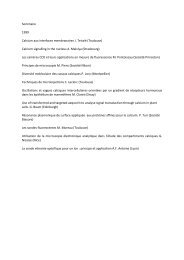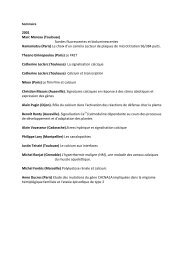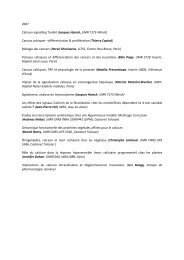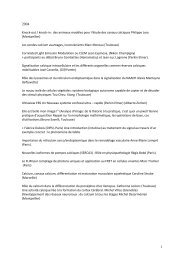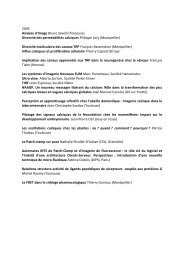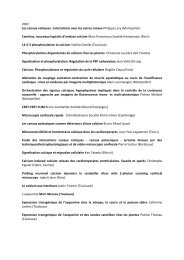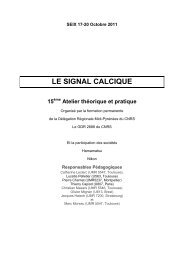SEIX 17-20 octobre 2005 - Atelier Calcium
SEIX 17-20 octobre 2005 - Atelier Calcium
SEIX 17-20 octobre 2005 - Atelier Calcium
You also want an ePaper? Increase the reach of your titles
YUMPU automatically turns print PDFs into web optimized ePapers that Google loves.
CALCIUM SIGNALLING IN DROSOPHILA CELL LINES AND PRIMARY<br />
CULTURES: COMBINING PHYSIOLOGY, RNA INTERFERENCE AND<br />
MICROARRAY STUDIES<br />
David B Sattelle, Steven D Buckingham and Valérie Raymond-Delpech<br />
MRC Functional Genetics Unit, Department of Human Anatomy and Genetics, University of<br />
Oxford, South Parks Road, Oxford, OX1 3QX, UK<br />
SUMMARY<br />
With the completion of the Drosophila genome project (www.flybase.org), the ready<br />
application of forward and reverse genetics, as well as calcium imaging and electrophysiology,<br />
this model organism offers exciting opportunities for the investigation of calcium signalling<br />
pathways. In particular the utility of an ease to culture Drosophila cell line (Schneider S2 cells)<br />
will be demonstrated. The cells can be conveniently deployed to study endogenous calcium<br />
signalling pathways and lend themselves to transfection with additional receptor /channel<br />
molecules. The application of RNA interference (RNAi) to Drosophila S2 cells and also to<br />
Drosophila neuronal primary cultures has facilitated the identification of novel calcium<br />
signalling components.<br />
INTRODUCTION<br />
Access to the genome of the fruitfly Drosophila melanogaster provides exciting opportunities<br />
for rapid advances in the functional analysis of gene products [1]. Such developments are<br />
further facilitated by the ease of expression of novel proteins in Drosophila cell lines, such as<br />
the S2 cells [2]. Also, the recent advances in gene silencing by double-stranded RNA<br />
interference (RNAi) permit rapid and direct investigation of protein function in cell lines [3].<br />
For example, a Drosophila S2 line expressing a musarinic acetylcholine receptor [4] has<br />
proved a particularly useful vehicle for studying components in the IP3 signalling pathway to<br />
which the receptor is coupled [5]. Primary cultures of Drosophila neurons also offer a<br />
suitable substrate for combined calcium imaging and RNAi experiments. Here we illustrate,<br />
using our own studies, how this approach can be used to identify the nicotinic acetylcholine<br />
receptor (nAChR) subunits that play a key role in the responses to nicotine of primary<br />
cultured larval Drosophila cholinergic neurons.<br />
FURA-2 BASED CALCIUM MEASUREMENTS IN DROSOPHILA S2 CELLS<br />
S2 cells are readily loaded with 2-4 M Fura-2/AM and 0.002% pluronic acid F-127<br />
dispersing agent in saline for 45 min at room temperature. The coverslip on which the cells<br />
are dispersed forms the base of the experimental chamber which is mounted on the stage of an<br />
inverted microscope equipped with a 40x, 1.3N.A. oil immersion objective. Using a filter<br />
wheel, cells are illuminated at 340 and 380nm. Emitted light is passed through a dichroic<br />
mirror set to 510nm and passed first to an image intensifier, then to a CCD camera [Fig 1]. In<br />
our laboratory the image acquisition and subsequent processing is performed using a Concord<br />
imaging system from Perkin-Elmer (UK). Imaging experiments are performed at room<br />
temperature; a pump and suction pipette maintain a constant volume of saline in the<br />
experimental chamber.<br />
91



